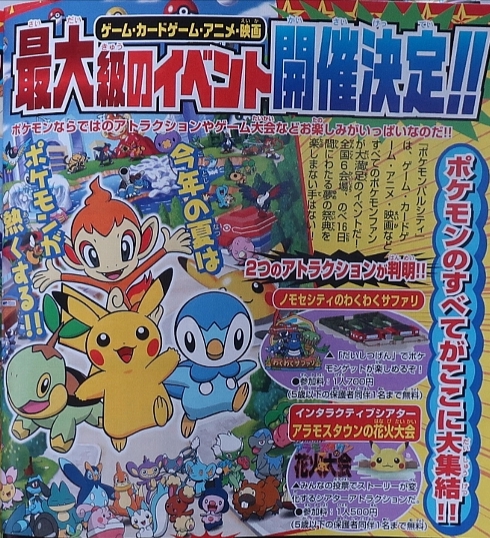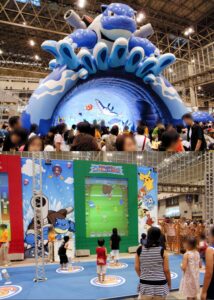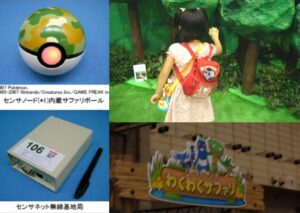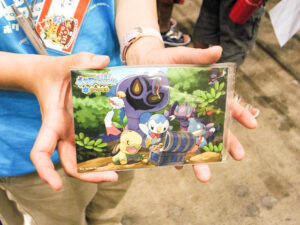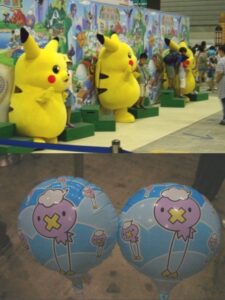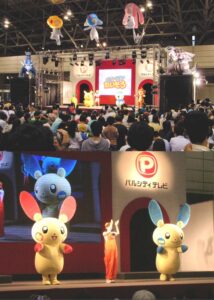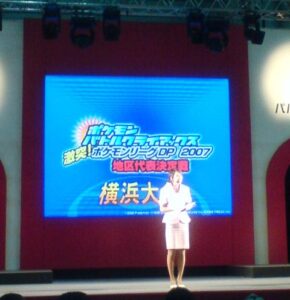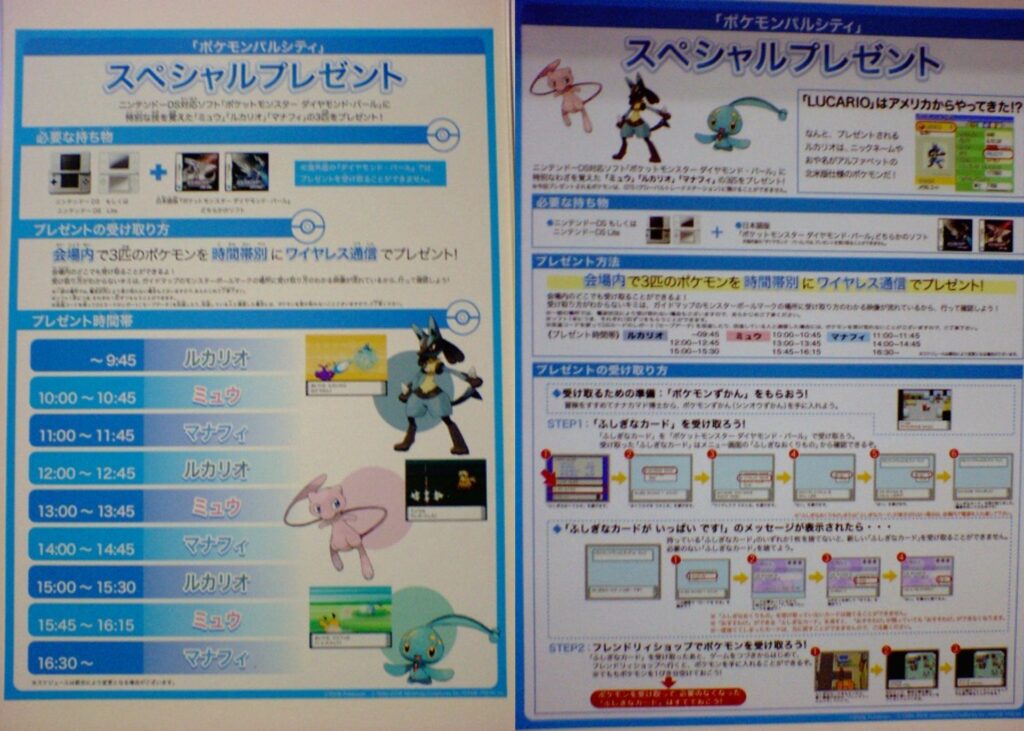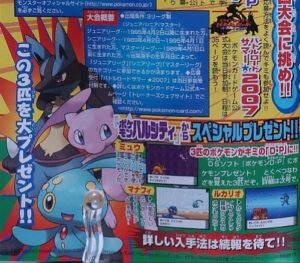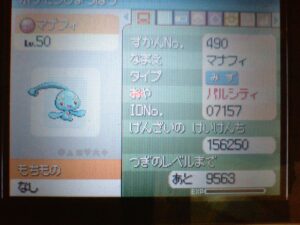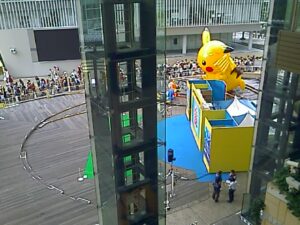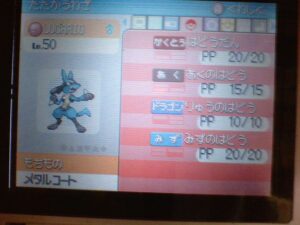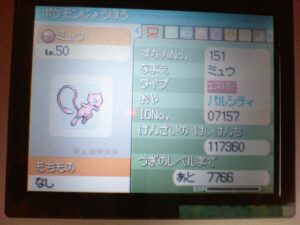“Two people battling, the audience watching it. […] Like sports, like football and baseball, the players made the audience excited! I was really impressed. I felt the power of the game again.”
PalCity. A place for Pokémon. A place for friendship. Okay, that wasn’t the event’s official tagline, but it may well have been. The sole edition of Pokémon Festa to be blessed with a subtitle, Summer 2007’s “PalCity” was an invitation to come befriend fellow fans and forge fresh bonds to start Generation Sinnoh.
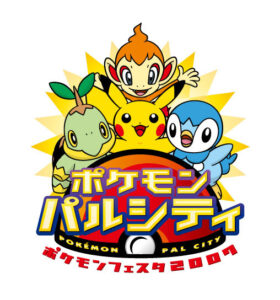
PalCity 2007 logo
Held annually between 2002 and 2008, Pokémon Festas were uniquely Japanese Pokémon mega-events that defy succinct description, but if I had to try, I might dub them something like a hybrid of Comic-con, a travelling funfair, and your local cardshop’s Sunday League, but with tens of thousands of passionate Pokéfans gathered under the same roof. PalCity Festa 20071Known in full as 「ポケモンフェスタ2007 ポケモンパルシティ」 in particular was monstrous – a highly-anticipated behemoth of a creature too successful for its own good after a transitional year.2Festa 2006 took place belatedly, in the heart of Winter instead of Summer, due to Pokémon Diamond & Pearl development delays having pushed back those games’ release dates, with consequences across the board for TCG and virtual League Play. It was replaced by a substitute funfair-esque convention, Jungle Tours, that also featured attractions and gifts. Due to security threats, Pokémon Festa 2008 was organised on a smaller scale with limited access (Daisuki Club members only). PalCity was organised by that exinclusive, members-only official Pokémon fanclub, the Daisuki Club (membership free!), and espoused the usual ambitious city-touring, Summer-spanning schedule, with six stops across Japan: July 15-16 in southerly Fukuoka, July 28-29 in northerly Sapporo, August 3-5 in Tokyo’s Makuhari Messe, August 10-12 in Nagoya, August 17-19 in Yokohama, and finally August 31-September 2 in Osaka.3You’ll notice some obvious gaps in this calendar. PalCity toured six venues, down from nine in 2005, with a stop in the Chūgoku region (Hiroshima / Okayama) and additional calls in Kanto absent from the calender. PalCity compensated to an extent via a midway-stop “Pokémon Day” weekend in Tokyo’s Roppongi Hills, July 21-22 that featured many of the same attractions. With oodles of fun packed into a single event, PalCity promised a great time for Pokéfans of all ages and persuasions.
… If they were able to enter successfully, that is. To be sure, as the Pokémon franchise’s premier annual get-together, Festas historically attracted a considerable number of visitors. PalCity 2007, however, was people-filled to the point of (over)capacity. It was, simply put, nuts. Nowhere was this almost unmanageable level of public interest more evident than in the human colonnades that wound and wrapped themselves around Festa’s domes, stradiums and convention centres. It would be remiss not to squeeze in mention of this, because the boiling agony of multi-hour outdoor waits in Japan’s blistering Summer heat was front and centre of most any firsthand account.
Prolific Pokéblogger “Pikachuftt”, for instance, queued for four total hours at Tokyo’s Makuhari Messe, of which three in a gargantuan sunscorched queue snaking away from the messe’s grand entrance, and then another hour inside the marginally cooler entrance hall. Murasaki’s experience, at Pacifico Yokohama, was similar: after arriving at a timely 09:40AM, they discovered to their dismay an enormous line that “made a U-turn in front of the venue and descended from the terrace to the park”. After three and half hours of waiting under the intense Summer heat, Murasaki finally entered around 1PM.4They later gathered that peak waiting times had reached five hours in Yokohama, and closing hours had been extended to compensate. In another example, Torogamer in Nagoya commented how he “had to wait endlessly outside under the scorching sun to enter the venue”, adding that there had been “a considerable amount of waiting time at venues in every region.” To give you a numerical indication, Makuhari admitted over 50.000 visitors on its opening Friday alone – and that’s just the people who entered successfully, ie. a tally exclusive of those who arrived too late to make the cut or noped out.5Source is nnk775. In a prudent move, the Daisuki Club ultimately put out a warning by email, cautioning prospective visitors to arm themselves against heatstroke.
Festa’s uniform magnetic pull raises some questions. Just why was PalCity 2007 so exceptionally popular, attracting a small city’s worth of visitors a day *and* persuading them to brave the queues en masse in the face of harsh environmental conditions? By way of comparison: the 2006 Winter Festa convened but a few months prior toured only four venues nationwide as opposed to PalCity’s six, yet was demonstrably less crowded (if still well-visited). So what gives? I can discern three main reasons: promotion, zeitgeist, and raw appeal.6Of course, PalCity was held over the Summer holidays versus Winter Festa’s less appealing Winter break scheduling, but the point still stands, particularly in comparison to the other mid-2000’s (Summer) Festas.
For one thing, advance promotional campaigns ensured that PalCity could escape no Pokéfan’s notice, as the event was backed by extensive coverage from both TV variety show Pokémon Sunday and manga periodical CoroCoro Monthly. On episode #136 aired May 20, 2007 – two months ahead of Fukuoka’s grand opener – Sunday launched a new “Road to PalCity” segment. In anticipation of PalCity’s casual and competitive TCG elements, for some eight straight weeks, the segment provided “battle intelligence” in the form of detailed analysis of a single high-powered TCG card. And of course, in practical terms, “Road to PalCity” made for a convenient weekly namedrop to hundreds of thousands of young viewers. For its part, CoroCoro published a double-pager in its June 2007 issue all about the upcoming Festa. Supported by a colourful boldface title that dubbed PalCity’s Pokémon’s “Premier Event”,7最大級のイベント the pages communicated venues and dates, showed off PalCity’s flagship attractions, laid out competitive League Play, and teased three giveaway Pokémon of Mew, Lucario, and Manaphy. This was a truly impressive allocation of print space, considering the competition with Movie 10 and Darkrai-related news! Pokémon Scoop, that free-of-charge biannual variety magazine, joined the fray with a full-page PalCity spread in its Summer 2007 issue. And to top it off, CoroCoro’s July issue followed through with a double-width full foldout PalCity page that once more relayed event dates and venues, and teased more attractions and activities. (Check here if you’d like to see it; it’s not that interesting.) Taken together, these pages dwarfed the attention Winter Festa had received in CoroCoro.

Pokémon Scoop, 2007 Summer issue. PalCity spread. Image credit: ICanSnake
But as you will have gathered, there was more to it than advertising. Festa’s visitor count boosted was by the sheer commercial success of Pokémon Diamond & Pearl. Selling over 5 million copies across Japan in a matter of months, these “unprecedented blockbusters” catapulted Pokémon back into the mainstream spotlight after years of dwindling popular interest.8「空前の大ヒット」, words of blogger Murasaki, at: http://murasaki-labs.org/library/palcity2007.htm In other words, by Summer 2007, Pokémon was very much (back) in the public eye after the transitional year 2006 (see also here). PalCity, in turn, was organised at the very crest of this new high, scheduled just weeks after the extensive Pokémon publicity campaign for landmark Movie 10 and its “Cinema Darkrai” event, distributed via newfangled wireless methods that spoke to the imagination of many. Moreover, fans considered PalCity the “first major event since the release of Diamond & Pearl”, expecting it to “to be more exciting than ever.”9「「ポケットモンスター ダイヤモンド/パール」発売後初の大型イベントということで、今まで以上の盛り上がりが期待される。」, words of Murasaki. In this spirit of the times, PalCity exerted an almost hypnotic pull on the Poké-fanbase, new and old.
Then thirdly, there was the promise of many unique and exclusive to-do’s and to-see’s. PalCity positioned itself to appeal to Pokéfans of all stripes by hosting an array of imaginative funfair-esque attractions, multiple family-friendly shows and activities under the Daisuki umbrella, plus casual as well as high-stakes all-Japan TCG and VGC competitions. Not to mention, of course, the free wireless gifts up for grabs! PalCity packed so much fun stuff into one event that, to be honest, it’s a bit overwhelming trying to do it all justice. But we gotta start somewhere, so let’s begin by examining the interactive attractions that CoroCoro had promoted.

PalCity 2007 Guidebook. The rear cover ft. Mew, Lucario and Manaphy reads “This Summer, get your hands on something new! (この夏キミは新たなかを手に入れる!)”
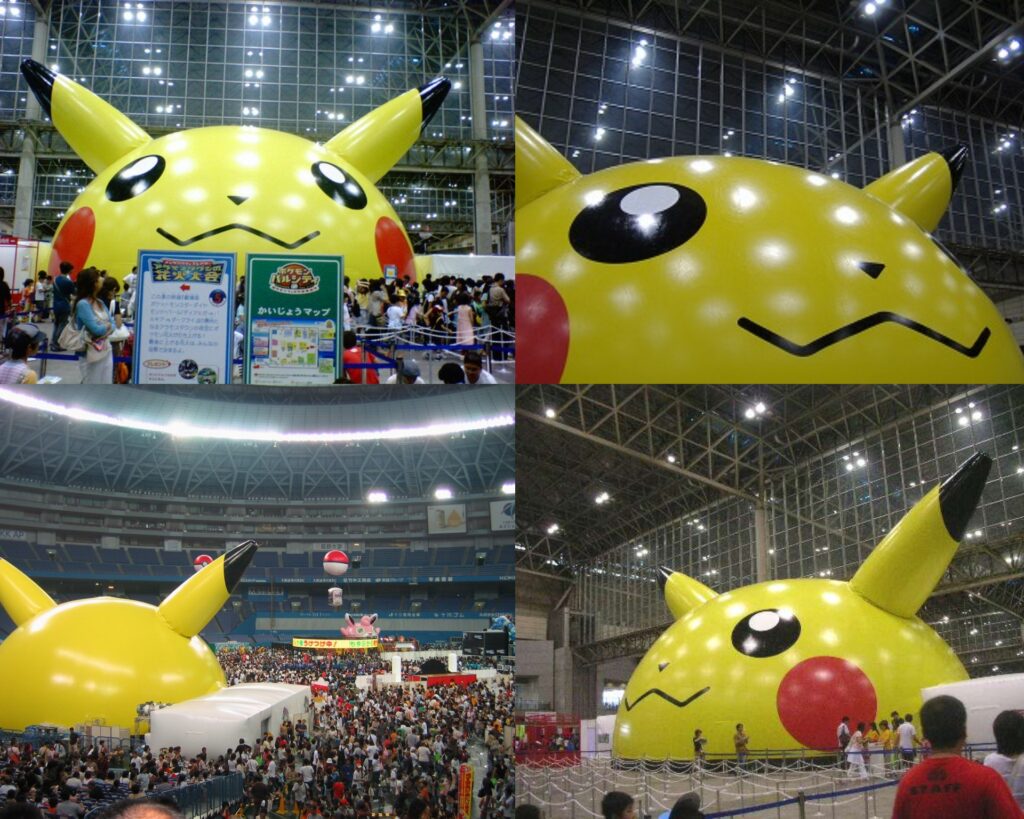
DomeKachu. Clockwise, from top-left: (1) On entry; (2) Closeup; (3) Reverse angle; (4) From high above. Image credit: Pikachuftt, Tetsufan, nnk775, goldenrodcity
So! Still reeling from heat exposure, visitors’ first order of business was to consult their “Official PalCity Guidebooks” that they had, presumably, received upon entering the venue. It instructed them to procure a “PalPoint Card”: An all-access slab of plastic that stored the event currency (¥1000 for 10 PalPoints) required to access the smorgasbord of carnivalesque attractions at fans’ fingertips.
Upon shuffling into the arena, guests had been greeted by the surprising sight of a giant dome-shaped Pikachu. And when I say giant, I do mean extremely large to the point of being unmissable and becoming easily the most photographed object at the convention. Photographs don’t quite capture its true scale; this contemporary PalCity video by era404 gives an impression of its true size around the 02:50 mark.
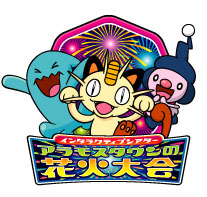 In any case, GigaKachu wasn’t just there to create ambiance; rather, it harboured an interactive theater inside of it (5 PalPoints)! Screening something called the “Alamos Town Fireworks Display” (アラモスタウンの花火大会), the story that played out on – I assume – the Pika theatre’s multiple equally gigantic displays changed in accordance with votes cast by the audience via Nintendo DS systems positioned in the theater. What this Movie 10-inspired story was exactly, I’m not 100% certain. It’s clear, however, that the finale was a digital fireworks show starring past Pokémovie protagonists (very 10th film anniversary) and that viewers could for vote either Dialga, Palkia or Darkrai to be its focal point. Inevitably, Darkrai invariably won this contest – yet more evidence that the Movie 10 Darkrai-oriented publicity campaign had found a receptive audience.10See for example accounts by nnk775 (in Makuhari) and poketure (in Osaka): http://nnk775.blog8.fc2.com/blog-entry-334.html and http://poketure.blog118.fc2.com/blog-entry-2.html?sp
In any case, GigaKachu wasn’t just there to create ambiance; rather, it harboured an interactive theater inside of it (5 PalPoints)! Screening something called the “Alamos Town Fireworks Display” (アラモスタウンの花火大会), the story that played out on – I assume – the Pika theatre’s multiple equally gigantic displays changed in accordance with votes cast by the audience via Nintendo DS systems positioned in the theater. What this Movie 10-inspired story was exactly, I’m not 100% certain. It’s clear, however, that the finale was a digital fireworks show starring past Pokémovie protagonists (very 10th film anniversary) and that viewers could for vote either Dialga, Palkia or Darkrai to be its focal point. Inevitably, Darkrai invariably won this contest – yet more evidence that the Movie 10 Darkrai-oriented publicity campaign had found a receptive audience.10See for example accounts by nnk775 (in Makuhari) and poketure (in Osaka): http://nnk775.blog8.fc2.com/blog-entry-334.html and http://poketure.blog118.fc2.com/blog-entry-2.html?sp
If guests found that too laid-back, they could try something slightly more fast-paced… A Blastoise footrace, for instance! Much like the PikaDome, the site of this attraction was hard to miss, situated as it was beneath an eye-catching, towering Blastoise statue perched atop an open azure clamshell. In “Blastoise GO!” (カメックスのあっち向いてGo! – 5PP) guests could take on the cannon turtle in a digital sprint. By running on the spot in a numbered, motion-sensing location, each participant controlled a Pokémon on a virtual track where they raced Blastoise AI to the line. To add a touch of unpredictability to the action, Blastoise did not shun the occasional use of Hydro Pump to slow down competitors. Quipped blogger “queen-0627”: “It’s like a Hydro Pump punishment…” Tut, tut. Cheeky! We’ll cut Blastoise some slack, however – how is else lumbering turtle supposed to win a sprint?!
Then there was the Nomose City “Wakuwaku” Safari (ノモセシティのわくわくサファリ – 7PP). Inspired by the popular attraction at 2005 PokéPark Nagoya, kids could go on a make-believe capture spree in the Great Marsh of Nomose (Pastoria) City. Kids were handed a true-to-size Safari Ball on entry, which was to be carried through the various prop-biomes inside the attraction to “catch” up to six Pokémon via infrared. Whenever a participant approached a Pokémon’s hiding place, their Safari Ball would begin to blink red, turning to solid red once in catch range. Then, if the player shook the Ball, it glew green and vibrated, “giving you the feeling that Pokemon has entered the Safari Ball”. It was neat mechanical design that replicated the “experience [and] feeling of catching a Pokémon.” It won’t surprise you to learn that, ahead of PalCity, the Nomose Safari had featured in June’s CoroCoro alongside the PikaDome; media outlet GameWatchImpress (GWI) considered the Safari a must-visit. Developers Hitachi were justifiably proud of their proprietary innovative tech that made this attraction possible – so much so that they published an article about it to their website. True story. Up to 80 people could play together at once, divided into four zones. After exiting, fans were given a glossy sticker-like printout of the Pokémon(s) they caught as a memento.
And so we arrive at the last of PalCity’s four main attractions and the event’s number one crowd-pleaser, if publication GWI was to be believed: playable demos of Mystery Dungeon: Explorers of Time / Darkness (5PP). Yeah. Due for release on Nintendo DS the month after Festa, in September, GWI found that PalCity had “quite a few test stands”. Fans were treated to a playable custom mission where, in traditional series gameplay, Pikachu and Charmander teamed up to crawl a dungeon and retrieve Spoink’s pearls.11It was apparently called「すすめ!みならい探検隊」 I must admit that this sounds like a non-too-riveting cookie-cutter industry demo, but evidently fans couldn’t wait to get their hands on the product, for “great processions” formed.12Words of Murasaki. Perhaps the real draw was the participation prize: a pair of gift postcards sporting gorgeous Ken Sugimori illustrations of i.a. Pikachu, Chimchar, Piplup, Turtwig, Arbok and Munchlax cracking open a treasure chest.13See Pikachuftt’s blog for scans of both postcards: http://pikachuftt.blog82.fc2.com/blog-entry-302.html Sure enough, the presence of the demo had been talked up in CoroCoro’s July issue.
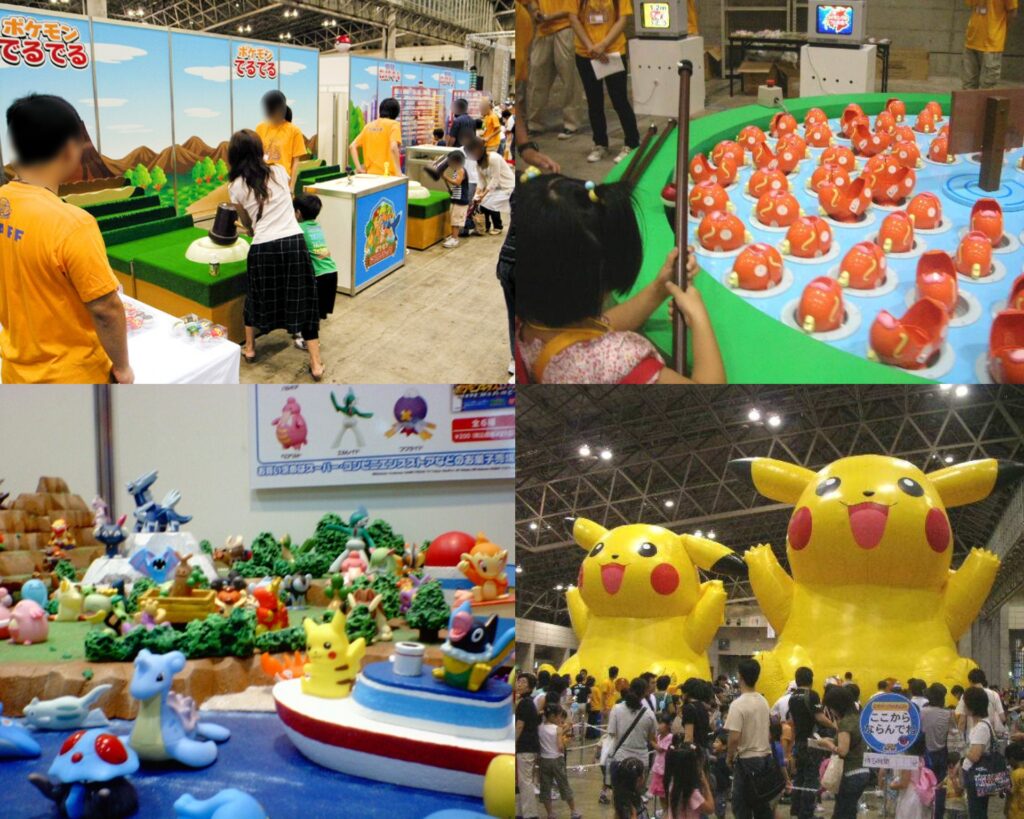
Minor attractions. Clockwise, from top-left: (1) Pokémon Athletics; (2) Magikarp Fishing; (3) Pika Ballpits; (4) Figurine Displays. Image credit: GWI, nnk775, Pikachuftt
Right. We shan’t spend too much time talking about PalCity’s (many!) minor attractions, for we’ve got a lot of ground to cover, but I do want to quickly highlight four of them. Most notable, in my mind, were “Pokémon Athletics”, a catch-all for a mishmash of sportsy activities aimed at having participants “experience the weight and speed of Pokémon” (3PP); the quirky Magikarp Fishing Tournament (コイキングの釣り大会) angling contest also seen at PokéPark Taiwan that had players fish for mechanical carp slowly gyrating on a pottery wheel, with length and points value of caught Karp shown on a scoring display; Pokémon “fuwafuwa” (ふわふわ), or monstrous 9m long ballpits set up inside of Wailmer and Pikachu inflatables – I think – for kids to “jump and play” in (3PP); and a Pokémon Battrio teaching corner to hook kids on an arcade-style Pokémon battle simulator demanding separately sold Pokémon-themed pucks. Naturally the event also hosted a PokéCenter affiliate store for visitors to splash the cash the old-fashioned way on common PC stock such as Pokémon plushies, keychains, and DS Lite swappable hardplates.
Now, before we shift our focus to Festa’s familiar competitive elements (we’re getting there!), I want to make one more brief aside. If PalCity was the high point of Sinnoh mega-events, Summer 2007 was the peak of Daisuki Club prominence. As the organisers of PalCity, Japan’s official Pokémon fanclub was allotted considerable floorspace presence with “lots of great … exclusive members events to enjoy.” The club operated a member exclusive “Shiny Studio” to get a professional photographer take your picture with a costumed Pikachu. Pity the six guys and gals in Pika-suits sweating it out all day, every day! The Daisuki Club “Experience Corner” (体験コーナー) made a return from Winter Festa, and was home to a variety of activities such as TCG beginner tutorials, figurine displays, and a 50-question Pokémon knowledge quiz that Murasaki passed without a single mistake. Their reward was a heartfelt “congratulations” from an attendant staffer. Nice.14The Daisuki Club’s popular Pikachu and Piplup drawing class did not make a return from Winter Festa. Early birds had the opportunity to snag themselves a goofy Drifloon stick balloon, with a limited quantity of 5000 available on a members-only first come, first serve basis. Further, the Daisuki gift lottery commanded considerable interest. To apply and enter, one had to complete a simple quiz for a chance to win one of 30 total PokéCenter exclusive Nintendo DS Lite Pikachu Editions.
The absolute centrepiece of fanclub Festa activity, however, was the familiar Daisuki Club livestage. Now branded the “PalCity TV” stage, it was watched over by giant Lake Trio balloons suspended above it (recycled from December 2006 WHF), and flanked by the life-sized Palkia & Dialga statues previously seen at Winter Festa. The Daisuki Club held costumed performances here, such as Plusle & Minun duo show, and also a Turtwig, Chimchar, Piplup and Pikachu synchronised dance show that must have felt like deja vu to past guests of Winter Festa. In between shows, the latest information on Pokémon was broadcast.15Source is Murasaki. Finally, live all-Japan Video Game Championship footage was also shown here, including the finals (see below).
—
Whew. Okay. You still with me? Competitive elements! First and foremost the TCG. PalCity covered all the bases here, from beginner’s tutorials to casual competition to official League Play with World Championships tickets on the line. To newcomers and the youngest of fans, the Daisuki Club offered “classroom-style teaching” (3PP) intended to familiarise its students with the basics of Pokémon cardplay and prepare the greenhorns for duels out in the wild.16It was called, in full:「ポケモンカードゲーム はじめて教室DP」 (See here). Catering to more seasoned players, PalCity held same-day walk-in tournaments, some with pre-built rental decks, others in the ingenious format of Movie 10-themed Dialga VS Palkia VS Darkrai team competitions (here). On the more serious side, PalCity hosted official League Play in the form of Battle Road Summer ★ 2007 (here). In a cool touch, participants received a Stadium promo card with “different illustrations depending on the venue”, all of which featured the iconic PikaDome. I can only begin to imagine how sought after this set must be today!17The set’s Chūgoku region print, which was available from Hiroshima Sun Plaza on August 25 and 26, 2007, is an odd duck. No PalCity was held in the region that weekend, nor were Battle Road tournaments held, indicating a possible last-minute cancellation that reduced planned venues from seven to six (or from eight, if Roppongi Hills is counted). Season’s end coincided with the final leg of PalCity, and the tournament’s climax was screened live on Osaka’s PalCity TV stage, September 2.18Regular bracket matches may have been, too, intermittently – I don’t really know.
Then, Pokémon Diamond & Pearl digital battling. (Inching closer!) As we’ve discussed elsewhere (here and here), Pokémon competitive battling really kicked into high gear with Generation Sinnoh’s easy all-access local and global WiFi connectivity. In an expression of this, PalCity presented not one, but three simultaneous D&P battle competitions. In order from beginner-friendly to cutthroat: a Daisuki Club 3-on-3 team challenge, the casual “Triple Beat” making a return from 2006 Winter Festa, and, mirroring the TCG, official “League DP2007” tournament play for the title of Japan grand champion and a ticket to proto World’s 2008 in Florida.
It was again the Daisuki Club that took WiFi battling freshmen by the hand. A VGC learning corner analogous to that of the TCG taught students “basic knowledge and tactics of Pokemon battle, how to raise Pokemon, and how to turn the tide of battle in your favour.” Further, the Club introduced and recommended strong Pokemon of each type to raise for battle, and provided handy type charts. Remember, this was before the games spoonfed players the effectiveness of moves contra the opposing Pokémon. Those not in need of Poké-education could take part in a 3-on-3 team challenge competition. Open to Club members only via pre-registration, the contest employed a doubles ruleset but, in a twist, each member could field but one Pokémon. While not something we’ll ever see at Worlds, it was a rather thoughtful approach (and initiative at large) that gave children an opportunity to compete alongside their parent(s).
As it had at the 2006 Winter Festa, the returning Triple Beat consisted of a consecutive battle challenge against fellow players. More broadly, the walk-in Triple Beat served as the de facto backup tournament to League Play, which admitted only a limited number of contestants decided by lottery. Perhaps in a reflection of this upgraded status, Triple Beat’s ruleset had been updated from experimental 3-on-3 doubles to the 4-on-4 doubles that was to become VGC standard. Not much was at stake except glory and the taste of victory, plus a bunch of Lake Trio badges.
Frankly more interesting in this context is that in Pokémon Sunday’s PalCity report (#146, aired July 29, 2007), resident comedian Akiyama took part in televised rounds of Triple Beat and did surprisingly well, scoring three consecutive victories. Besides this, Akiyama and pals Baba and Yamamoto toured whatever PalCity venue they were at, and… Well, that’s all I know. Sunday provided extensive reporting from PalCity in an earlier Summer Special (ポケモン☆サンデー 夏の特別号) that had aired July 15, 2007 outside of normal show hours.19It promised to deliver a “detailed investigation” of PalCity (ポケモンパルシティを徹底調査!) However, this feature episode is not available anywhere on the web, so I can’t determine what it might have told viewers about Triple Beat, League Play, or even the gifts of Manaphy, Lucario, and Mew. C’mon, TV Tokyo, digitise your old content and put it online, folks want to see this stuff!
Anyhow, League Play. The real deal. Known in full as “Pokémon League DP2007” (ポケモンリーグDP2007), this was an officially-sanctioned double battles competition comprised of tournaments held at each of the six regional PalCity venues: Fukuoka, Sapporo, Makuhari, Nagoya, Yokohama, and Osaka. Each crowned two district winners, one per age category: elementary schoolers on the one hand, and junior high students and above on the other. The competitive action culminated in grand finals in Osaka, September 2, where the 12 total district champions stood to lock horns and “determine the number one Pokémon trainer in Japan”. Well, the two number one trainers. From what I understand, there was no monetary reward on offer – though I did come across word of a plasma TV grand prize. Which seems like a strange trophy for an elementary schooler, so take this notion with a grain of salt. It is perfectly clear, however, that Victory Commemoration (ゆうしょうきねん) Ribbons were awarded to the victorious Pokémon of each district champion.20I assume that these were physical objects rather than in-game ribbons; I haven’t been able to find any pictures. Of course, the all-Japan grand winners also bagged tickets to Florida to represent Japan at the 2008 Showdown.21 Source for this latter fact is this Wikipage.
Now, Pokémon video game battle tourneys weren’t anything new. For years and years, they’d been held on local and national levels, first over link cables, then through wireless adapters, and now over the airwaves unaided. Yet PalCity’s Pokémon League was noteworthy because in this very tournament, we can discern the seeds of competitive Pokémon’s transformation into (inter)national flagship eSport and premier spectator attraction. For one thing, the matches of the tournament finals were broadcast to the PalCity TV stage for a live audience to consider. While it might sound self-evident that the finals were livestreamed over the internet, the year 2007 pre-dated the digital broadcast boom, and as far as I know, no such livestream happened. However, a kind soul rode to the rescue and uploaded crowd’s perspective grand finals battle footage to YouTube the very day of the championship deciders, September 2 2007. Covering the finals of both divisions, the clips have since amassed over half a million views apiece. Check them out here and here. These videos are perhaps what blogger “laborfox” referred to in their contemporary comment that even though they regretfully couldn’t attend the championship deciders in person, he / she got to enjoy them nonetheless “because I could see it on the internet.”22Their PalCity blog here: https://laborfox.hatenablog.com/entry/24180775 PalCity’s organisers did potentially put out something akin to a PalCity report, though I have no idea how it was delivered, and what it contained.23The official website had promised to “report on the local situation from event venues nationwide starting July 18”. See here: https://web.archive.org/web/20070716185953/http://www.pokemon.co.jp/palcity
In any case, for many spectators in the flesh and on the web, PalCity’s finals marked their first taste of what would later become Pokémon eSports. This fact was far from lost on a very special guest. In attendance in Osaka on September 2 to witness the League’s finals, GameFreak’s Junichi Masuda eyed proceedings with keen interest. Happily for us, Masuda later jotted down his observations in stream of consciousness format on his blog, writing:
“A tremendous number of spectators! A strange excitement when a technique is decided! The venue is sizzling with 12 people aiming to be the best in Japan!”24もの凄い観客の数!技が決まったときの異様な盛り上がり!日本一を目指す12名で、会場は熱い!熱い!
As the knockout tournament progressed and the championship deciders approached, excitement reached fever pitch, leading Masuda to deliver these impressionist words:
“The best match in Japan was held on stage. Two people battling, the audience watching it. Yes, this is the game! The game is great. Like sports, like football and baseball, the players made the audience excited! I was really impressed. I felt the power of the game again.”25戦う2人、それを見守る観客。そう、この姿こそ、ゲーム!そう、ゲームの素晴らしさです。スポーツのようにサッカーや野球のように、プレイヤーが観客を沸かしてくれました!本当に感動しました。
改めてゲームの底力を感じました。
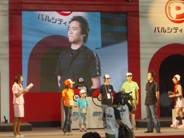
Masuda on stage in Osaka amidst the action. Source: Masuda Weblog
If you ever wanted to know what was the watershed moment when the future of competitive Pokémon was determined, it was right here, September 2, 2007, in Osaka’s Yahoo Dome. Masuda was unequivocal, stating on his blog how he’d “like to continue to hold nationwide battle competitions in the future”, before declaring even more boldly: “I want to hold a world competition on a global scale!”26「今後も全国規模のバトル大会を行っていきたいですね。(…) やっぱり、地球規模で世界大会もやりたい!!!」 At the risk of committing teleology, PalCity’s VGC tournament can retroactively be interpreted as a road test for future (world) championships. And sure enough, a proto VGC World’s materialised within 12 months of Masuda’s proclamation with 2008’s global “Showdown” tournament in Orlando, Florida. “Public Pokémon battles with a lively feeling that connects with the audience” were indeed “really great”, and the future was to see a heck of a lot more of them.
—
Alright. Let’s shift gears one final time, and focus on PalCity’s trio of distributable event Pokémon. Many, many who came to Festa 2007 were less concerned with its attractions or with battling, and instead preoccupied with the prospect of collecting. (We made it!) While not unprecedented, the combination of Pokémon up for grabs was certainly extraordinary. Manaphy was the first (guaranteed) free-of-charge blue blob after the paid-for Ranger and DVD Manaphys (here); Lucario was the first of its kind to be distributed in event form; and Mew – the very first since Emerald’s Old Sea Map two years prior. As noted blogger Torogamer, a good amount of Pokéfans likely travelled in primarily to secure the distro Pokémon. And indeed, a number of people explicitly described it as their “main purpose” in coming, for instance “poketure”, who journeyed four hours by bus from the countryside to Kyocera Dome, Osaka. The influx of these event fans contributed to the queuing mayhem outside referenced earlier in this article – particularly since the gifts were unreceivable in the space surrounding the venues. By design or otherwise, the distribution signal was nowhere strong enough to reach outside the complexes.27Although Torogamer anecdotally tells of an adaptive response by PalCity staff. In Nagoya in the early morning hours, with queues already escalating ahead of opening time, an ad hoc brief window was apparently instated where one, or multiple, of the distribution Pokémon could be received outdoors. See: http://torogamer.fc2web.com/game2007.2/palcity.html
In contrast to the mounting chaos outside, indoors all was tranquil on the distribution front – or as tranquil as a venue packed to capacity could conceivably be. Large, centrally-mounted LCD panels played back animations to signpost the availablity of Mew, Manaphy and Lucario. A Pokéball ceiling balloon with a dangling banner that read “Pokémon Presents” did the same.28I can’t make out the words exactly; it’s something like 「ポケモンXXXXプレゼント」 As did distribution posters pinned on pillars and walls – posters which moreover revealed that the trio was to be given out on an hourly rotating schedule, starting with Lucario at 9:00-9:45AM, then Mew from 10:00-10:45AM, then Manaphy at 11:00-11:45AM, then back to Lucario, and so on. While certainly an elegant alternative to tripling the necessary amount of wireless equipment, these rotations only served to slow the turnover of visitors. People “sat inside the venue waiting for time to pass – myself included”, commented Torogamer, thereby inadvertently worsening the situation outside. In any case, the fact that Manaphy, Mew and Lucario were downloadable from every venue nook and cranny invited much wonder. Tetsufan wrote of his experience in Makuhari that “you could receive the delivery anywhere in the venue”. Bany.bz, also in Makuhari, corroborated this: “We can communicate almost anywhere in the building.” Pukubyi in Fukuoka equally found that “it was possible to receive them anywhere in the [Yahoo] Dome”, and finally, Murasaki praised Festa on account of the “multiple distribution devices installed to cover the entire venue, so that they [the trio] can be picked up anywhere”, adding how this was “a good way”.29Only “poketure” found that in Osaka, “although the pamphlet said that they could be (received) anywhere in the venue, the radio waves arrived only near the distribution location”. See: http://poketure.blog118.fc2.com/blog-entry-2.html?sp
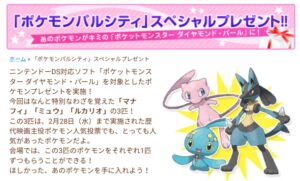 So, let’s take closer look at each of the three, as we can assume recipients did. I’ve not mentioned it yet, but GameFreak’s decision to give away Mew, Lucario and Manaphy was premised on, and perhaps inspired by, initially unrelated polling earlier in the year. A public vote – dubbed the “Movie Protagonist Popularity Contest” – had been conducted online and through CoroCoro Monthly to determine an event Pokémon preorder bonus for Movie 10. Deoxys triumphed (see also here). Runners-up and third-placed were – you guessed it – the pairing of Mew & Lucario, and Manaphy.30It’s worth noting that the exact Popularity Poll results, including vote shares and even the order of podium finishers, are lost to time. That Mew & Lucario finished above Manaphy is probable, but uncertain.
So, let’s take closer look at each of the three, as we can assume recipients did. I’ve not mentioned it yet, but GameFreak’s decision to give away Mew, Lucario and Manaphy was premised on, and perhaps inspired by, initially unrelated polling earlier in the year. A public vote – dubbed the “Movie Protagonist Popularity Contest” – had been conducted online and through CoroCoro Monthly to determine an event Pokémon preorder bonus for Movie 10. Deoxys triumphed (see also here). Runners-up and third-placed were – you guessed it – the pairing of Mew & Lucario, and Manaphy.30It’s worth noting that the exact Popularity Poll results, including vote shares and even the order of podium finishers, are lost to time. That Mew & Lucario finished above Manaphy is probable, but uncertain.
The pokemon.co.jp official website announced the trio of PalCity gifts on May 14, 2007. As was practically the norm, the CoroCoro June issue released concurrently (May 15) also promoted the available event Pokémon. More details surfaced in June, when a dedicated distro information page previewed what to expect. For reasons left unexplained, Lucario was to be North American in origin. Okay. Furthermore, each of Mew, Lucario and Manaphy was to know one or more “special moves”.31特別なわざを覚えた For Mew, the page explained, these were to be Teleport and Aura Sphere; for Lucario, “four Pulses”; and for Manaphy, its signature Heart Swap. All of which, of course, were film references. However! Collectors soon discovered surprising dimensions to Manaphy and Lucario, while Mew packed hidden-in-plain-sight secrets that the official pages either ignored or were entirely oblivious to. So let’s go over them in reverse order, and find out what was up.
Starting with Manaphy. Like mentioned, PalCity Manaphy was the third such blue blob distribution in twelve months’ time, after the Prince of the Sea Ranger Egg Manaphy and the DVD / WHF “Water Tribe” Manaphy. As opposed to the first two, this iteration came at Lv.50 and packed a moveset befitting of a Mythical. Out of Heart Swap / Water Pulse / Whirlpool / Acid Armor, the first attack was the obvious selling point which, the official site emphasised, was accessible normally only at Lv.76. PalCity Manaphy’s OT was an appropriate パルシティ (ie. parushitei, or “PalCity”) and its TID was 07157 in reference to the Summer event’s opening day. It had no held item, not even a thematic King’s Rock, and finally, PalCity Manaphy had random natures. Well, mostly.
We’ve seen how Pokémon Festa toured only six venues in 2007 – notably fewer locations than in prior years. Perhaps to fill the weekend’s worth calender gap left between PalCity stops at Fukuoka and Sapporo and keep the party going, a “Pokémon Day in Roppongi Hills” 「ポケモンデーin六本木ヒルズ」was held at and around Roppongi Hills Arena on the weekend of July 21-22, 2007.32In a direct link to Festa, the event’s official website explained away its inspiration to readers as marking the arrival of PalCity. See here: https://web.archive.org/web/20070715082344/http://www.pokemon.co.jp/info/event/e070706_05.html Sure enough, many of the (more portable!) “fun projects unique to Pokémon PalCity” appeared in Roppongi’s Pokémon Day, including stage liveshows, the Pikachu photo-op studio, the Mystery Dungeon demo, the Battrio corner, and the Pika bouncy castle. … Plus the distribution of PalCity Manaphy. Not Mew, and not Lucario. Only Manaphy.
We know from wondercard analysis that Roppongi’s Manaphy was nature-locked to Hardy, as Fukuoka’s had been before it. However, in the intervening week between Pokémon Day and PalCity’s arrival in Sapporo, someone at GameFreak messed with Manaphy’s wondercard metadata and altered its parameters to permit random natures. Manaphy’s SID was tweaked too. We may never know what inspired this seemingly rather pointless mid-event modification that a casual player was unlikely to notice, much less care about. But the fact is that, for purposes of historical of record-keeping, this minor tweak turned the Pokémon Day official site’s claim that its Manaphy was “the same as the Manaphy presented at PalCity” into a falsehood. There were, in fact, two master variants of PalCity Manaphy, though you wouldn’t know it unless you had access to large -n comparisons or an under-the-hood peekaboo.
Right. LUCARIO. Hadouken! Hmm? No, Lucario didn’t transiently join the Street Fighter roster. And no, I haven’t lost my marbles. (I think!) You see, PalCity Lucario was delivered knowing four “outstanding” hadou moves that, per the official website’s blurb, “enabled one to fight flexibly”. Said moves were Hadou Bomb, Dark Hadou, Dragon Hadou, and Water Hadou;33 Respectively:「はどうだん」「りゅうのはどう」「あくのはどう」「みずのはどう」 attacks that we know in English as Aura Sphere, Dark Pulse, Dragon Pulse and Water Pulse. (Not Hadouken, sadly!) Seems rather random at first glance, doesn’t it? But it’s really not. Hadou (はどう) can mean different things. In its more mundane reading, hadou is interpreted as “wave motion” (波動), or “pulse”. More esoterically, the Pokémon franchise imbued the term with a deeper connotation. In 2005’s Pokémon film Lucario and the Mystery of Mew, hadou is explained to be the magical life essence inherent in all living things. Western translations use the term “Aura” for this lifeforce concept, leading to the divergent translations of Hadou Bomb and Aura Sphere. It’s a pity that PalCity Lucario’s clever quadruple hadou moveset is lost in translation, but I guarantee you that in Japanese, it works like a charm.
It gets more intriguing still. The previous paragraph’s all-caps denotation was not mere whimsy on my part: PalCity Lucario was, in fact, expressly advertised as “North American”, with a nickname (“LUCARIO”) and OT (“PALCITY”) to match. Why so? Good question. Nobody seems to truly know! Surprised players couldn’t identify a clear-cut reason behind the Pokémon’s transpacific origin. “It came from America?”, wrote our old chum bany.bz in confusion. The way I see it, PalCity Lucario’s designers may have had two synergistic motivations. Firstly, while Movie 8 doesn’t make it crystal-clear that Lucario’s master, Sir Aaron, is of Western origin, his name, appearance and knighthood are highly suggestive thereof. Never mind that honorary titles are characteristic of Britain rather than North America! If Sir Aaron is an overseas import, then it follows that his Lucario must be, too. Secondly, how convenient, then, that Diamond & Pearl had just been released in the United States and Europe in April and July 2007 respectively, making unfettered international trading through the so-called Global Trade Station (GTS) now a reality (see also here). Seen in this light, the decision to make PalCity Lucario of English origin helped call attention to the exciting new possibilities of global Pokémon exchange – much like the concurrent initiatives of GameFreak Psyduck and Nintendo of America Heracross also did. Sure enough, the official site’s description of PalCity Lucario happily name-dropped the GTS, telling readers: “This is your chance to get a North American version of a Pokémon that you cannot easily acquire without using the GTS. Let’s seize this opportunity!”34We’ve not even touched upon the fact that PalCity Lucario held a Metal Coat which, the site explained, could be given to Scyther or Onix to facilitate trade evolution. Talk about random!
Then finally, Mew. Where a young fan could airily inform his dear blogger mom “ganbarion” that it wasn’t necessary to stick around for PalCity Manaphy because he already owned two of the clione Pokémon, nobody in their right mind was prepared to forego that eternal crowd-pleaser, Mew. I imagine that the inevitable sidejob event farmers and/or resellers (as reported by madeinore) very much sought to load up on the bubblegum Pokémon over Manaphy and Lucario. But I digress. If the official website was to be believed, PalCity Mew’s primary selling point was the fact that it knew two Movie 8 homage attacks: Aura Sphere and Teleport.35You may recall that in the film, Mew uses group Teleport to frivolously whisk Pikachu (and Rocket’s Meowth) away towards its treefort hideout. It was admittedly a tall order for the PalCity PR team to try and excite players about the practical in-game uses of Teleport, but that didn’t stop them trying. Noted the official website: “Teleport is a convenient way to ensure that you can escape from wild Pokémon battles, and if used in the field, it quickly returns you to the last Pokemon Center you stopped by.” Fabulous! It had been that way since Red & Blue! In all seriousness, Teleport isn’t part of Mew’s standard learnset, so there was that, I suppose. Mew does get Aura Sphere in routine play but only at Lv.100. Next, PalCity Mew also knew Metronome, and in the final slot, it carried… Hmm.
Here’s the thing. Of all the interesting Mew factoids that CoroCoro’s June 2007 issue could have talked about when introducing PalCity Mew, it chose to highlight the pink Pokémon’s universal TM capability.36Writing: 「すべてのわざマシンを使うことができるポケモンた。」 Similarly, May’s initial pokemon.co.jp announcement emphasised how “you can use all TMs!”.37Writing:「全てのわざマシンを使うことができる!」 Once is happenstance, twice reflects an agenda. Right? Or so you’d think. Fans were instinctively left wondering whether PalCity Mew might carry an assortment of stonking TM attacks such as Fire Blast, Thunder or SolarBeam. But… Nope. PalCity Mew’s creators partially followed through on their universal-learning foreshadowing, in the sense that each of PalCity’s six event venues distributed Mew with a variable fourth move. Disappointingly, however, said moves were drawn from Mew’s standard level-up movepool. As such, in addition to Aura Sphere / Teleport / Metronome, Fukuoka’s knew Transform, Makuhari’s Mega Punch, Nagoya’s Psychic, Osaka’s AncientPower, Sapporo’s Amnesia, and Yokohama’s Barrier. Quite the missed opportunity to deliver something truly timeless!38In a quirk similar to Lucario’s, Fukuoka Mew was locked to Quirky nature (how appropriate), whereas the other five had random natures.
Some closing thoughts. Reflecting on PalCity 2007 as a whole, it’s apparent that Festa’s Daisuki organisers left no well untapped in putting together an appealing all-ages event package. The plenitude of goodies, playable demos, unique attractions, major competitive elements, not to mention free admission, made PalCity a must-visit for any Pokéfan. While Festa was a traditional Pokémon Summer highlight, one can’t help but sense that there was a lot riding on 2007’s edition being a return to form. PalCity was effectively a reboot after the transitional year 2006, when Festa had skipped a beat, and it was clearly in the franchise’s best interest to pull out all the stops, bring fans together, win their hearts and minds and start molding a dedicated community for Generation Sinnoh. The distribution of the three wireless gift Pokémon – of which two high-profile Mythicals – can be seen in this light, with the 10th film popularity poll conveniently doubling as market research that indicated Mew, Lucario and Manaphy would get people in the door.
And they did. Fans overwhelmingly heeded the call. It’s remarkable how successful PalCity was, regularly drawing in 50.000-plus daily visitors throughout its all-Japan tour. Both the quantity and quality of surviving third-party PalCity commentary is astounding, and the many in-depth personal blogs – far more numerous than I can possibly hope to cover here – speak to a genuine enthusiasm about Sinnoh’s fresh 2.5D, wireless era of Pokémon. Looking back, there’s something profoundly magical about this glorious new dawn, physically represented by Pokémon mega event of incredible scope. PalCity looked like a ton of fun. How I wish I could have been there to experience it!
- Harvest Moon 3 (2001) - March 5, 2020
- Pokémon Trading Card Game 2 (2001) - February 5, 2020
- Yu-Gi-Oh! Dark Duel Stories (2002) - January 5, 2020


